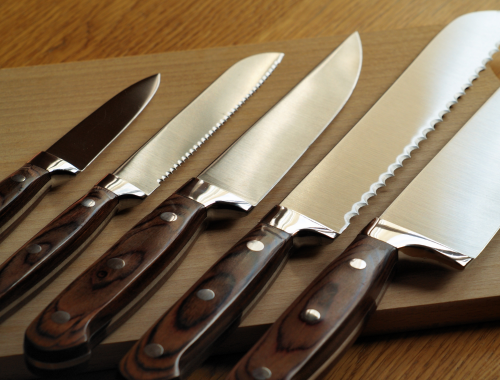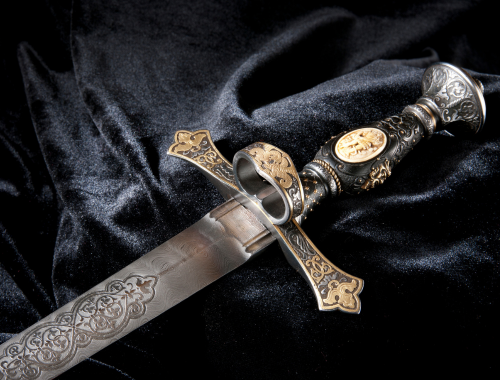Difference Between a Knife and a Dagger
There is a common misconception that a knife and a dagger are basically the same. But that is not the case. It’s true that knives and daggers are two of the most commonly used bladed weapons. They look pretty much the same both in use and structure. While these terms may be used interchangeably in certain contexts, they are two very different tools with different features and uses. In the following article, we break down the key differences between a knife and a dagger. After reading the article, you will understand that the similarities between the two only exist in their looks.

What is a Knife?
A knife is a standard household tool used for cutting, slicing, or chopping fruits or vegetables. Knives come in a single-edged or double-edged blade structure and in a variety of shapes and sizes, each designed for specific purposes. For example, a chef knife is a chef’s most versatile go-to tool used for slicing, chopping and mincing. Then there’s bread knife or butter knife which comes with serrated blades and is used for slicing bread or applying butter on the bread. Pocket knives are knives with a folding blade and can be easily carried into pockets for multipurpose use. Knives are made of a wide variety of materials, such as stainless steel, carbon steel, titanium, and ceramic. There are hundreds of varieties of knives available in the market, each specific to a particular use. Different knives have different handles.

What is a Dagger?
Contrary of knives, daggers are double edged with relatively thin blade and are mainly used for combat. A dagger has a sharp front end and is designed to penetrate more quickly. Daggers are mostly used for thrusting or stabbing people or animals. They are typically made from high-quality steel or other durable materials, and are designed to be both lightweight and strong. Compared to knives, daggers are heavier allowing them to exert more force to inflict more damage. Daggers have been used as a weapon of choice for assassinations for centuries. Scottish Dirk is a type of dagger with a straight blade and a Stiletto is a dagger with a tapered blade and is used for the sole purpose of piercing armor and other hard materials. Typically, a dagger ranges from 5 to 12 inches in length.
Difference between a Knife and a Dagger
- Shape – Knives typically have a single-edged or double-edged blade with a curved or straight shape, while daggers always have a double-edged blade with a sharp front end that is designed to penetrate more quickly.
- Purpose – Knives are a common household tool designed primarily for cutting, slicing, or chopping. Knives are a handy tool used for cutting, cooking, hunting, etc., while daggers are designed primarily thrusting or stabbing people or animals.
- Size – Knives come in a variety of shapes and sizes, each designed for specific purposes, from small pocket knives to large chef’s knives, while daggers are generally smaller and more compact, designed for easy concealment.
- Weight – Knives are often heavier and bulkier than daggers, which are designed to be lightweight and easy to maneuver.
- Thickness – Knives may have thick or thin blades, depending on the intended use of the weapon, while daggers typically have a thin, pointed blade.
Knife vs. Dagger: Comparison Chart

Summary
In a nutshell, daggers are mainly designed for combat skills with both edges completely sharp to inflict more damage when penetrated. The handles are made to be used comfortably with both the hands. Because of their sleek blade and intricate hilt, daggers are designed primarily thrusting or stabbing people or animals. Knives, on the other hand, are a standard household tool used mainly for cutting, slicing, chopping or mincing. Unlike daggers, a knife blade is shard on one side and uniform on the other. The knife blades are wider at the base with a dull end to avoid self injury.
What makes a knife a dagger?
If a knife is more symmetrical with double-edged blade that is extremely sharpened at both the ends, then it is a dagger. The pointed tip of the blade is designed to penetrate armor or stab a person or an animal. Basically, dagger is an unusual type of knife
Which is better knife or dagger?
Both a knife and a dagger have different designs and purposes. A knife is a tool for daily household chores like cutting, slicing, or chopping, while a dagger is primarily used for combat skills and self protection.
Is a dagger bigger than a knife?
Not necessarily. Daggers are typically smaller and more compact, and lightweight compared to knives. This makes them easy to conceal and handle. The purpose of a dagger is to inflict severe damage.
Is dagger a knife or a sword?
Dagger is more like a sword because the difference between the two is much less prominent. For example, a Rapier Sword is pretty much identical to a dagger with its sleek blade and intricate hilt, and they are designed for stabbing or thrusting.
Can you own a dagger in Canada?
It is legal to own a dagger in Canada but there are restrictions to how daggers can be used and carried in public. There are some additional restrictions regarding possession of daggers in some provinces.
Can you call a dagger a knife?
Dagger is an unusual type of knife and both are often confused with one another. However, both knives and daggers have different designs and purposes. Daggers are specifically designed for stabbing or thrusting, so it is not always appropriate to call a dagger a knife.
- Difference Between Caucus and Primary - June 18, 2024
- Difference Between PPO and POS - May 30, 2024
- Difference Between RFID and NFC - May 28, 2024
Search DifferenceBetween.net :
Leave a Response
References :
[0]"The Main Differences Between a Knife and a Dagger You Must Know About." Knife Depot, 28 June 2018, https://blog.knife-depot.com/the-main-differences-between-a-knife-and-a-dagger-you-must-know-about/.
[1]Peterson, Harold L. Daggers and Fighting Knives of the Western World: From the Stone Age Till 1900. Mineola, New York: Dover Publications, 2001. Print
[2]Thompson, Leroy. Fairbairn-Sykes Commando Dagger. London, United Kingdom: Bloomsbury Publishing, 2011. Print
[3]Frieman, Catherine and Berit Valentin Eriksen. Flint Daggers in Prehistoric Europe. Oxford, United Kingdom: Oxbow Books, 2015. Print
